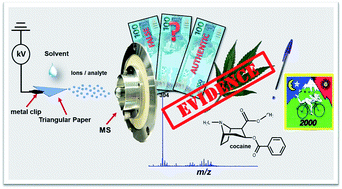Paper spray ionization mass spectrometry applied to forensic chemistry – drugs of abuse, inks and questioned documents†
Abstract
With the advent of a new family of ionization techniques, ambient mass spectrometry (or ambient MS) was introduced as a simple way of generating ions in MS. Among them, the paper spray ionization (PS-MS) technique has demonstrated to be versatile to solve numerous problems in many areas of science. In this work, the PS-MS technique in the positive ionization mode (PS(+)-MS) was applied in two subareas of forensic chemistry: drugs of abuse and documentoscopy. In the first, the PS(+)MS technique was applied to obtain the chemical profiles of illicit drugs such as blotter papers containing 25I-NBOMe, extracts and leaves of natural cannabinoids (Δ9-tetrahydrocannabinol) and synthetic cannabinoids (naphthalen-1-yl-(1-butylindol-3-yl)methanone, (JWH-073); n-(adamantan-1-yl)-1-(4-fluorobutyl)-1H-indazole-3-carboxamide (5F-AKB48); 4-methyl-1-naphthyl-1-pentylindol-3-yl-methanone (JWH-122); 2-(2-methoxyphenyl)-1-(1-pentylindol-3-yl)ethanone (JWH-250); and 4-ethylnaphthalen-1-yl-(1-pentylindol-3-yl)methanone (JWH-210)) as well as to determine the authenticity in weight-loss herbal samples. Finally, an analytical method has been developed to quantify eight illicit drugs (3,4-methylenedioxyamphetamine (MDA), 3,4-methylenedioxy-N-methylamphetamine (MDMA), 3,4-methylenedioxy-N-ethylamphetamine (MDEA), meta-chlorophenylpiperazine (m-CPP), methamphetamine (MA), cocaine, lysergic acid diethylamide (LSD), and dimethoxybromoamphetamine (DOB)) where their limit-of-detection ranged from 0.17 to 1 ppb, with linearity R2 > 0.99. The performance of the PS(+)-MS technique was also compared to other ionization sources: leaf spray mass spectrometry (LS-MS), and electrospray ionization mass spectrometry (ESI-MS). In the second part of this study, the PS(+)MS technique was successfully able to obtain the chemical profiles of different commercial blue pens. The relative intensity (RII372) of the methylene blue dye was monitored to discriminate crossings of traces, and to date questioned documents. The chemical profile of the second generation of Brazilian banknotes (R$, reais) was also explored. In general, the PS(+)-MS technique was proved to be an excellent analytical tool in forensic chemistry, acting like a “Swiss army knife”.



 Please wait while we load your content...
Please wait while we load your content...